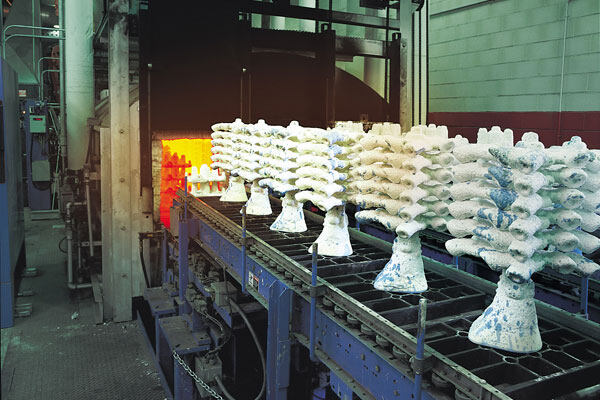Памылка фармату электроннай пошты
emailCannotEmpty
emailDoesExist
pwdLetterLimtTip
inconsistentPwd
pwdLetterLimtTip
inconsistentPwd

Навіны
lost wax casting equipment,low wax casting,lost wax bronze
What we call bronze is an alloy of red copper, tin and lead. Due to the properties of bronze itself, it cannot be processed by beating and forging like iron, but by melting the alloy into molten liquid and then processing it. Fan casting and lost wax casting are both methods of bronze casting.
How are bronzes made?

✔️What is Fan Casting?
Compared with the low wax casting, the Fan casting method is more common in the development history of bronzes in China. The so-called Fan casting method is to use special mud to make the shape of the bronze ware according to the needs, to make a hollow pottery billet, and use the temperature of about 600 degrees to cast it. The pottery billet is fired into a pottery model for later use. Before making a bronze ware, the pottery model before pouring is preheated, and then molten copper liquid is poured into the pottery model. The solution is cooled, and the bronze ware is taken out.
Most of the bronze wares are cast separately, or called secondary casting. In the bronze wares of the Shang and Zhou dynasties, some wares have moving parts, such as the beams of the yǒu, which are connected to the wares, which cannot be completed by one-time casting, followed by the split casting method, which is to cast the small parts first, and then put the cast small parts on the main model, and cast them, which is an extension and progress of the fan casting method.
✔️What is the lost wax bronze?
The lost-wax method is another common and mature casting process in bronze casting. The academic community generally believes that the lost-wax method became popular in the middle of the Spring and Autumn Period, but it was found in the literature records later. Spring Goods is the first book to record this process, but there is controversy. Another book "Dongtian Qinglu Collection" compiled by the Song Dynasty was the first to record the entire process of the lost wax method.
✔️The process of the lost wax method:
- Use easily melted materials, such as yellow wax, animal oil, etc. to make the wax model of the object to be cast;
- A layer of mud shell is formed on the surface of wax mould by pouring fine mud on the surface of wax mould for many times;
- Coat the surface of the mud shell with refractory material to harden the model to form a casting mold. If the refractory material is not used for coating, it can also be filled with van soil, and the gap of the wax mold can be filled and sealed into a cylindrical shape;
- Baking this model, the wax oil melts and flows out to form a cavity;
- Pour metal solution into the cavity to obtain a smooth and precise casting without fan marks.
The lost wax method began in the late Spring and Autumn period and has been developing for more than 2,000 years. In addition to the different materials used in different periods, the production methods are basically the same. The difference is that the modern lost wax method can be reused with the same mold, which greatly reduces the production cost. The lost wax casting equipment is more precise than before.
What did the ancient lost wax method look like?
The ancient lost wax method is also known as the investment method. The specific method is to pile the plastic clay fan core first, and then paste the wax sheet on the fan core after drying in the shade, so no casting in summer. Carve all kinds of exquisite patterns and complex hollow shapes on the wax model, weld various accessories such as feet and ears, and iron gate rods and exhaust holes.
Next, apply a very fine mud slurry evenly on the surface of the wax mold without leaving any gaps. After drying in the shade, wrap the outer layer with grass mixed with mud. After drying in the shade again, wrap it with low-temperature baking mud, so that the wax layer inside melts and flows out of the vent (the wax can be reused).
The clay bag is baked at a high temperature of 850 degrees to make the clay bag form clay. Then the mud is buried in the ground and copper water is poured inward.
Finally, after the copper water solidified, the inner and outer fans were broken, and the bronze ware was taken out and polished.
The general method of the modern lost wax method is similar to the ancient method, except that refractory materials such as quartz sand, mullite powder and corundum powder are used. The production method does not have the link of stacking the model core, and directly makes the wax model.
Then brush the wax mold with water glass and fine quartz sand, and thicken it layer by layer to form a touch shell:
It is followed by wax baking, embedding, and casting.
How to judge the authenticity of bronze ware?
In general, we judge the authenticity of a bronze ware, in addition to comprehensive judgment from the rust color, decoration, inscriptions, etc., but also depends on the production method. If we extract modern materials such as white quartz sand, which are not Sanhe clay or pottery clay, from the dead ends of the bronze ware, it can also be judged as a modern imitation.
Of course, there are counterfeiters who use the ancient method to make imitation utensils, using white paste mud, black charcoal mud, glutinous rice juice, vegetable glue and other materials to completely follow the ancient method, but the things they make are still there. There are flaws, such as natural oxidation for hundreds of thousands of years, changes in the internal structure of metals, and simplicity in ornamentation.

